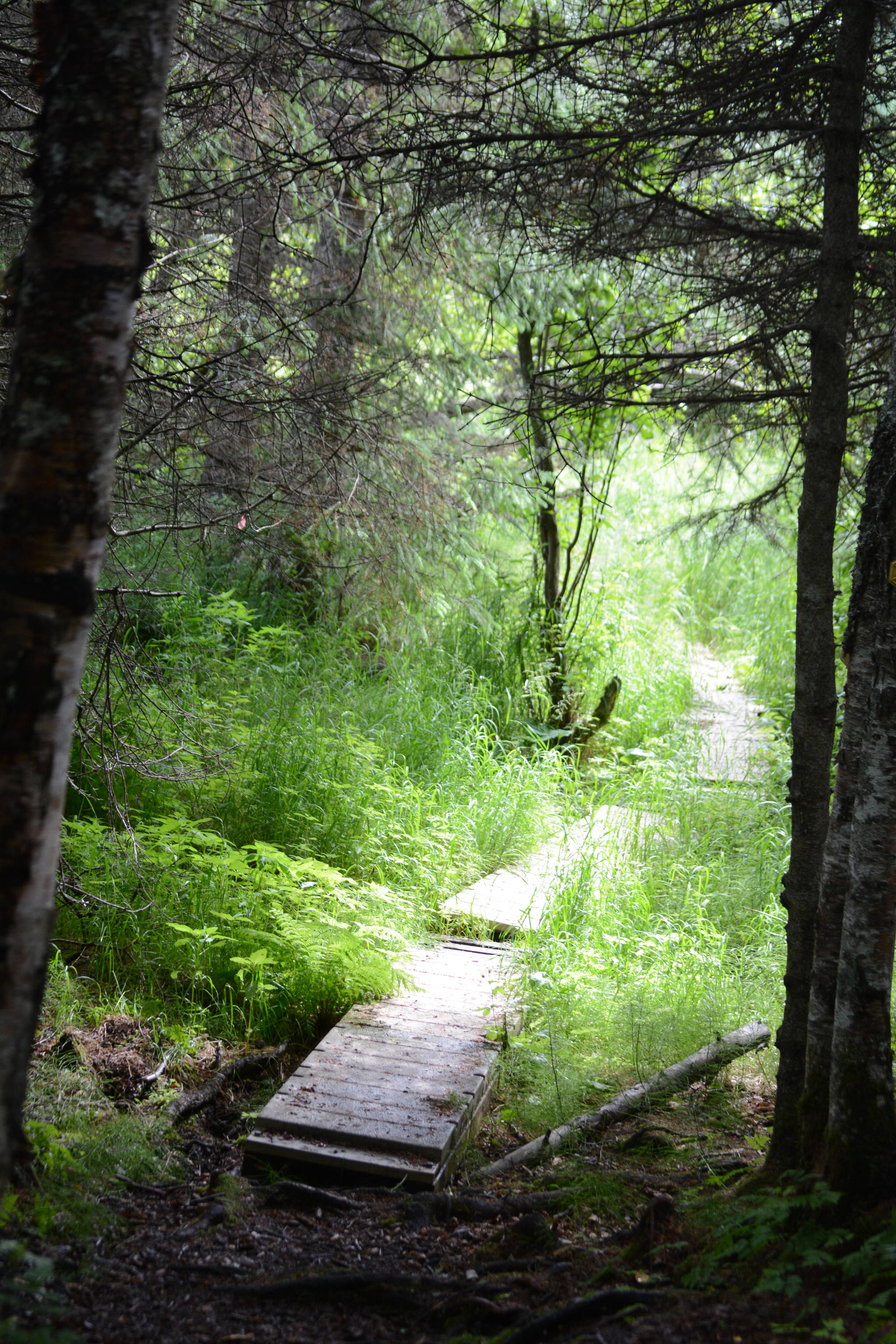Hikers walking Alaska’s many trails know to take water, food, extra clothing, a First Aid kit, and, in the event of bears, bear spray or even firearms, but they might not think of a lawn rake.
That’s what Kachemak Heritage Land Trust Stewardship Coordinator Joel Cooper equipped himself with last Thursday when he went to check on the Mariner Drive Trailhead of KHLT’s Calvin and Coyle Trail. Since July 6, a forested section of the trail has been closed because of an aggressive goshawk protecting its nest. Cooper got swooped by the goshawk when he went to check on reports of hikers being attacked in early July. He didn’t see a goshawk on July 27, but later inspections found the goshawk still there.
Cooper contacted local wildlife biologists Jason Herreman with the Alaska Department of Fish and Game and Jeff Williams with the Alaska Maritime National Wildlife Refuge. Williams suggested Cooper carry a rake, broom or umbrella when inspecting out the trail.
Actually, KHLT would rather people not even try the dangerous section of the trail. Herreman and Williams said the goshawk could protect its nest through July and maybe into early August. After the reports of attacks, KHLT closed the Mariner Drive Trailhead. The trail can still be accessed from a trailhead off the Paul Banks Elementary School parking lot. “Trail closed” signs have been placed at the Mariner Drive Trailhead and at the section of the Paul Banks trail where it meets the Mariner Drive part.
About 1.5-miles long to its end at a viewing platform on Beluga Lake, the Calvin and Coyle Trail is one of Homer’s more popular nature trails.
“It’s an amazing trail,” Cooper said. “It gets used so often.”
A land conservation group, KHLT manages both land and conservation easements donated by property owners. It received the Calvin and Coyle property in 1991 from D. Bailey Calvin and Maurice J. Coyle. In 1997, Harry L. Buxton donated another section adjoining the property. The first nature trail was built in the early 1990s with volunteer efforts coordinated by Richard Purington and Rick Randall. Carpenters Dave Rector and Jerry Frederick built a viewing platform on Beluga Lake. A connecting trail was built to Paul Banks. The spruce bark beetle infestation, with deadfalls and dead trees, changed the character of the trail.
In 2008, the Homer Soil and Water Conservation District got a grant from the Alaska Division of Parks and Outdoor Recreation for a Calvin and Coyle Woodland Park Nature Trail redevelopment project. From 2009-2010, that project rerouted parts of the trail, put in new boardwalks and established a parking lot and kiosk at the end of Mariner Drive.
More recently, on July 13, KHLT staff and volunteers put in 150 feet of new boardwalk in a wet section on the eastern viewing platform loop. Cooper said one unidentified user even hauled a few boards, saying, “I use the trail so much I should chip in.”
On a warm mid-summer day, hiking the trail feels like immersion in a pool of green. Birch leaves fill out trees in a small forest close to the lake, and new growth on spruce trees shows they’re recovering from a spruce aphid attack in 2016. Even though the sun shone, I got a drenching from high grass wet from a morning fog and a rain the night before. Rain pants and rubber boots are advised. Be careful on wet boards and take caution stepping over roots and logs.
Earlier in the summer, the forest can be a symphony of songbirds. On birding-by-ear walks, I’ve heard olive-sided flycatchers, fox sparrows, golden crowned sparrows, Townsend’s warblers, and varied and hermit thrushes. By July, most of the calls came from fledgling birds chipping for their parents. Even though the woodland park is near busy East End Road, in the thick forest it’s easy to find quiet and a pocket of nature.
The trail ends at the viewing platform, with views of upper Beluga Lake and the Kenai Mountains. A birch tree nicely frames a look at Grewingk Glacier. During shorebird season, it’s a good place to spot greater white-fronted geese, sandhill cranes and the secretive Beluga Lake pair of swans. Moose often graze in the wetlands.
Cooper said he’ll keep checking the Mariner Drive trailhead. Warning signs will be posted closing that section of the trail until the danger of the goshawk is gone. Meanwhile, enjoy the rest of the trail.
“This is like a little gem, this trail,” Cooper said. “People love it.”
Michael Armstrong can be reached at michael.armstrong@homernews.com.


